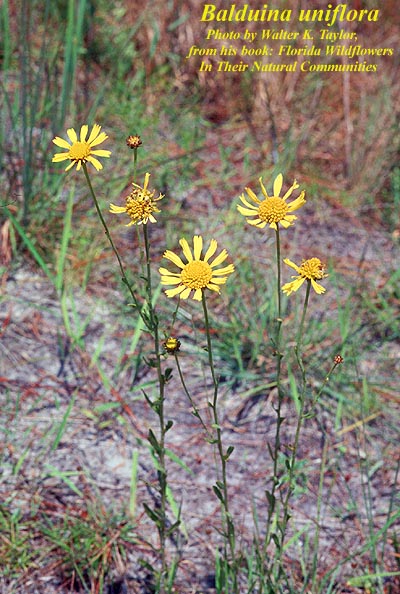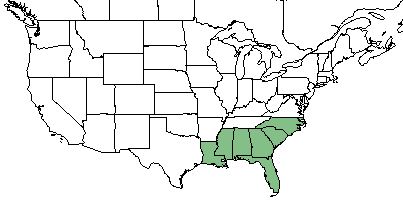Difference between revisions of "Balduina uniflora"
(→Pollination) |
|||
| Line 39: | Line 39: | ||
===Pollination=== | ===Pollination=== | ||
| − | Pollen grains are 40-45 µm in diameter.<ref name="Parker & Jones 1975"/> | + | It attracts bumblebees and butterflies which pollinates it.<ref name="Pitts-Singer et al 2002">Pitts-Singer TL, Hanula JL, Walker JL (2002) Insect pollinators of three rare plants in a Florida longleaf pine forest. Florida Entomologist 85(2):308-316.</ref> Pollen grains are 40-45 µm in diameter.<ref name="Parker & Jones 1975"/> |
<!--===Use by animals===--> <!--Herbivory, granivory, insect hosting, etc.--> | <!--===Use by animals===--> <!--Herbivory, granivory, insect hosting, etc.--> | ||
<!--==Diseases and parasites==--> | <!--==Diseases and parasites==--> | ||
Revision as of 17:28, 29 January 2018
| Balduina uniflora | |
|---|---|

| |
| Photo by Altas of Florida Plants Database | |
| Scientific classification | |
| Kingdom: | Plantae |
| Division: | Magnoliophyta - Flowering plants |
| Class: | Magnoliopsida - Dicots |
| Order: | Asterales |
| Family: | Asteraceae |
| Genus: | Balduina |
| Species: | B. uniflora |
| Binomial name | |
| Balduina uniflora Nutt. | |

| |
| Natural range of Balduina uniflora from USDA NRCS Plants Database. | |
Common Names: savanna honeycomb-head;[1] oneflower honeycombhead[2]
Contents
Taxonomic Notes
Synonym: Endorima uniflora[1][2]
Description
Balduina uniflora is a dioecious perennial that grows as a forb/herb[2] and has fleshy roots. It reproduces vegetatively from root stocks and can reach heights of 0.7-1.0 m. Inflorescence contain 1-3 heads, each with ray flowers 8-22, 5.5-8.2 mm long and 1-2 mm wide. Flowers are yellow.[3]
Distribution
It is found from eastern Louisiana, eastward throughout the panhandle of Florida and southeastern Georgia, and northward to southeastern North Carolina.[2]
Ecology
Habitat
This species is found in wet pine savannas, pine flatwoods,[1] and the margins of pitcher-plant bogs.[3]
Phenology
In the southeastern and mid-Atlantic United States, flowering occurs from late July through September.[1] Another, study reports flowering starting in June.[3]
Pollination
It attracts bumblebees and butterflies which pollinates it.[4] Pollen grains are 40-45 µm in diameter.[3]
Conservation and Management
Cultivation and restoration
Photo Gallery
References and notes
- ↑ 1.0 1.1 1.2 1.3 Weakley AS (2015) Flora of the Southern and Mid-Atlantic States. Chapel Hill, NC: University of North Carolina Herbarium.
- ↑ 2.0 2.1 2.2 2.3 USDA NRCS (2016) The PLANTS Database (http://plants.usda.gov, 26 January 2018). National Plant Data Team, Greensboro, NC 27401-4901 USA.
- ↑ 3.0 3.1 3.2 3.3 Parker ES, Jones SB (1975) A systematic study of the genus Balduina (Compositae, Heliantheae). Brittonia 27(4):355-361.
- ↑ Pitts-Singer TL, Hanula JL, Walker JL (2002) Insect pollinators of three rare plants in a Florida longleaf pine forest. Florida Entomologist 85(2):308-316.